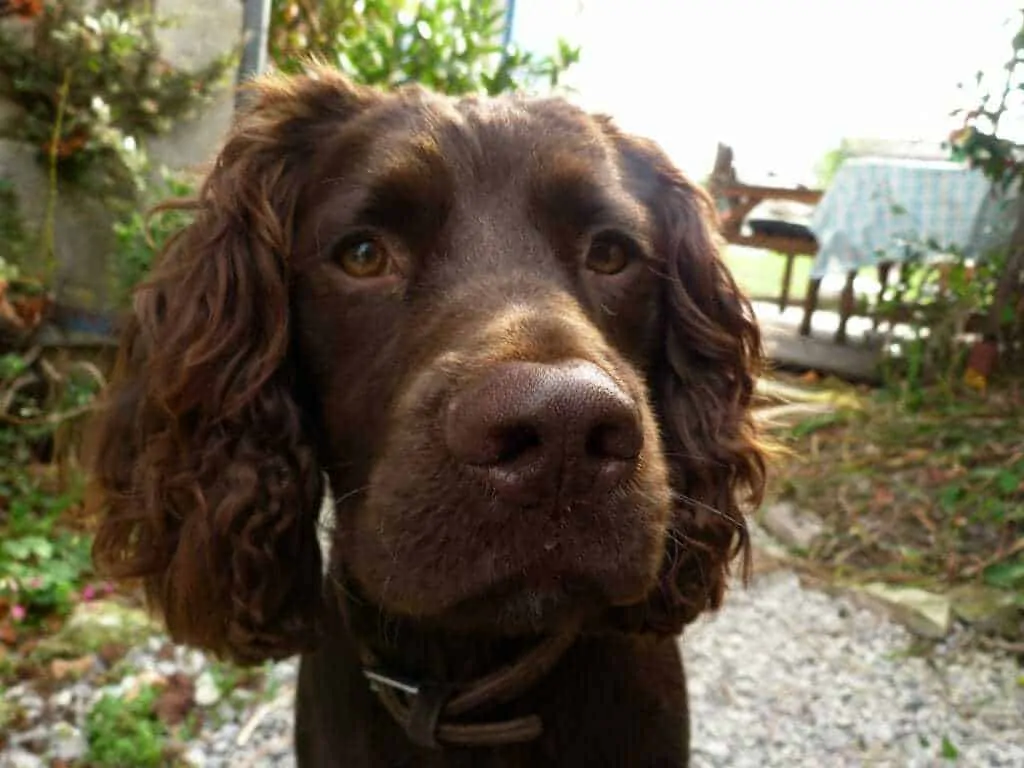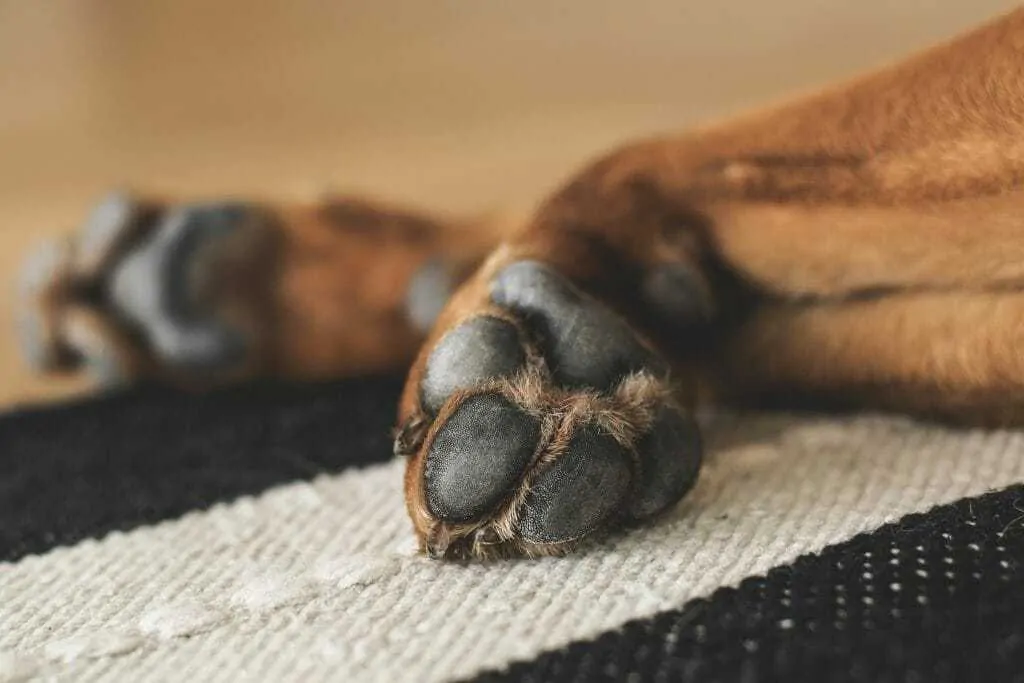What dog doesn’t love the outdoors!? My cocker spaniel Alfie certainly does. There is nothing he loves more than running through the countryside as fast as he can without a care in the world. A member of the gun dog family, spaniels are well-known for needing large amounts of exercise, up to two hours a day is recommended with plenty of opportunities for them to make the most of their instincts and have a good hunt around is ideal.
Alfie the Cocker Spaniel
The only problem in Alfie’s case is that we live in an area where the soil is packed with flint. And for those of you who are familiar with flint, you will know how sharp it can be! I am sorry to say that my dear Alf is fairly familiar with cut paw pad, having charged full tilt across are field peppered with flint stones. Depending on the seriousness of his cuts, he has occasionally had to visit the vet but when less severe, these injuries are in actual fact very treatable at home.
Contents
Your dog’s paw pads
An integral part of your dog’s feet, paw pads provide not only protection but also added insulation during colder periods. Made up of a pigmented fatty tissue, paw pads act as shock absorbers whilst running, as well as assisting with balance, helping them to slow down when stopping and are well-designed to withstand large amounts of regular exercise. However, you may notice the paw pads on your dog’s feet are either smooth or a little rough. This is entirely dependent on the terrain they tend to walk on. For example, if your dog requires little exercise and prefers to walk on soft grass surfaces their pads well be smooth to touch. Whereas if, like My dog Alfie he can runs for miles over tougher terrain, your dog’s paw pads may not be as soft.
Dog paw pads
The important thing to remember is that, as with the base of our own feet as humans, your dog’s paw pads are very important and an injury that can occur at any time during their life, (even the smallest) can cause excruciating pain for your dog. Which is precisely why, care and attention for their paws is very much needed, just as much as, for example, grooming their coat and ensuring a healthy diet.
Paw pad injuries
As mentioned above, your dog may incur a paw pad injury at any time and despite their durability, they can occur due to ongoing wear and tear or perhaps in the case of my spaniel Alfie, sharp objects, such as flint stones.
A common injury, dogs can cut their pads at any time, particularly if they get lots of exercise. Beaches are a perfect example of a place where your dog may injure themselves on a sharp rock or on a piece of litter.
If your dog has injured their paw pad you may notice one of the following common symptoms:
- You may spot your dog limping and unable to put pressure on their foot
- They might be licking their foot excessively
- Their pad could be bleeding
- Your dog’s paw pad might be red, inflamed or swollen
- You may notice a tear or an abrasion on the paw pad
- If dry, their pads may be cracked
- Depending on the severity of their injury you may notice loose skin or a torn nail
Whether you notice one or more of these symptoms, the important thing to remember is to remain calm. Paw pads in dogs are renowned for bleeding excessively so do not be alarmed if you notice blood, to begin with. Initially, you should keep your pup happy and rested, allowing you to take a proper look at their injury in order to clean and examine it.
Treating your dog’s paw pad injury at home
I will begin by saying that if you notice your dog has injured their paw pad and you are not confident that you can treat it at home, or you do not feel it is healing well or most important, there are any signs of infection, call your dog’s vet straight away. I cannot stress this enough. However, if you are confident that they have just a minor scratch on the paw pad, you will be pleased to hear that this area is incredibly quick to heal and will do so with a little extra help from you, at home.
Alfie bandaged and sleeping after one of his more serious paw pad injuries
Four simple steps to treating your dog’s paw pad injury at home:
- Keep it clean – Depending on where your dog injured their paw pad, it is important before bandaging the wound that you clean it. Check for foreign objects and be certain to clean the area of any debris/general muck. The best and easiest way to do this is in a bowl of water and the use of an antiseptic ointment may also be beneficial.
- Stop any bleeding – As with any wound, apply pressure to control bleeding. Take into consideration that bleeding may reoccur and of course, don’t forget that if you cannot stop bleeding in your dog’s paw within 15 minutes, you should ring your vet.
- Bandage the wound – Once the wound is clean and the bleeding has stopped, you should apply a bandage. Begin by adding a gauze pad to the base of the foot for added comfort and wrap with a bandage. To ensure the bandage is not too tight, you should be able to insert two fingers between the bandage and your dog’s foot.
- Keep the bandage clean – To promote healing, your dog’s bandage should be changed daily. If you notice your dog chewing or licking their bandage, you may want to add an extra layer for added protection and a sock can work perfectly for this. During the healing period, you should avoid excessive exercise but when your dog does venture outdoors, an outer plastic protection may be required over the top of their bandage.
Once again, it doesn’t go without saying that if you are not comfortable treating an injury of this kind in your dog at home, or if you are not confident that their wound is healing properly, always telephone your dog’s vet for advice.
Preventing paw pad injuries in your dog.
Sadly, a paw pad injury in your dog may not always be preventable. However, there are ways you can lower the risks of injury in your dog.
If possible, avoid walking your dog in areas where you know they are likely to sustain an injury from any sharp objects. However, I appreciate this is not always possible and I have found a paw pad balm applied daily to your dog’s paws can help keep them in great condition.
Some alternative treatments for cracked paw pads.
In addition, if you are concerned your dog may cut their pads whilst out on a walk, boots are a wonderfully effective and inexpensive option. However, your dog may take a little while getting used to them.
Paw pad injuries in your dog are never nice but it is important to remember that they are incredibly common and they are a resilient area, that is able to heal quickly so your dog can get back to being their normal crazy selves. I can’t tell you how many times my cocker spaniel Alfie has injured himself on the flints that are so common in the area we live and although the majority of the time these injuries are not at all serious, if you are at all concerned, don’t hesitate to pick up the phone and book an emergency appointment to see your dog’s vet.




